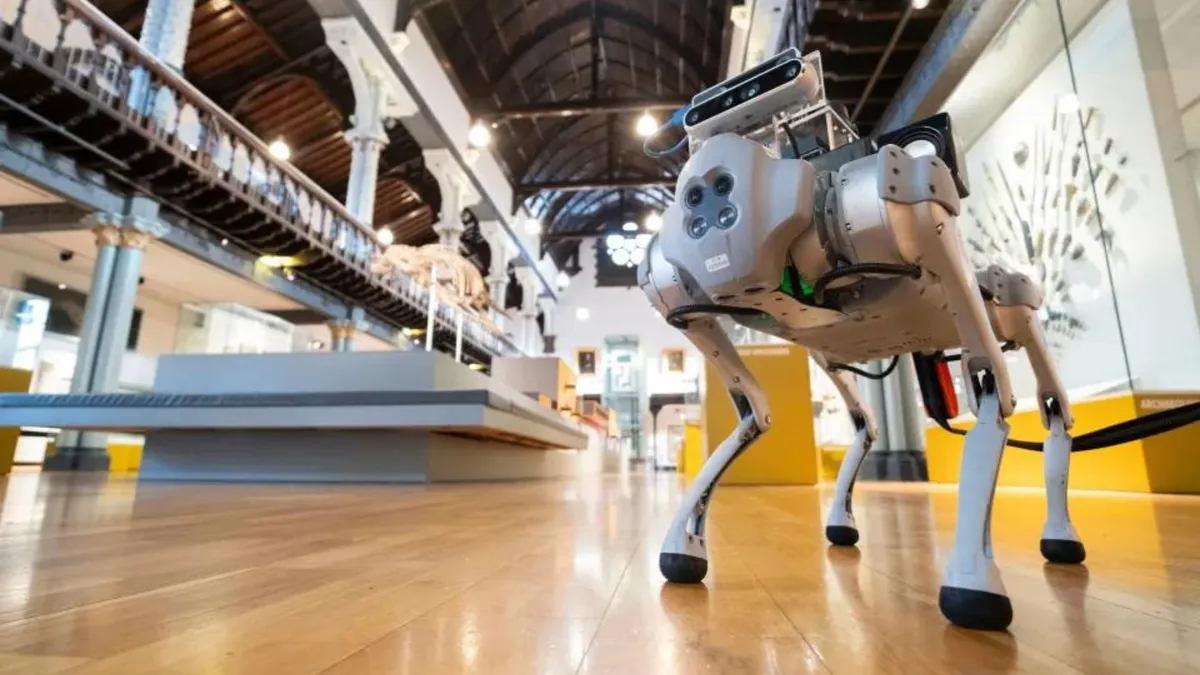
Blog Articles
How Quadrupeds are Pioneering Advances for the Visually Impaired
February 21, 2024 — 2 minutes
In an era where technology bridges the gap between capability and aspiration, quadruped robots emerge as beacons of hope for the visually impaired. DroneBlocks, at the forefront of integrating cutting-edge robotics into education, offers the Unitree quadruped robot, a sophisticated device. This initiative enhances robotics and computer science programs and lays the groundwork for significant advancements in healthcare, particularly for those with visual impairments.
Researchers at the University of Glasgow and the Thomas J. Watson College of Engineering and Applied Science at Binghamton University are leading parallel projects that underscore the potential of quadruped robots in aiding visually impaired individuals. Though miles apart, these initiatives share a common vision: to enhance the autonomy and mobility of those with sight loss, leveraging the advanced capabilities of robotic technology.
Transformative Projects Unveiled
The University of Glasgow’s project, RoboGuide, is an AI-powered quadruped robot designed to navigate public spaces, such as museums and shopping centers, offering independence to visually impaired individuals. Meanwhile, at Binghamton University, Assistant Professor Shiqi Zhang, alongside PhD student David DeFazio and junior Eisuke Hirota, has embarked on creating a robotic seeing-eye dog. Their work highlights the adaptability and potential of quadrupeds in providing guidance and support through a unique leash-tugging interface, enabling the robot to navigate indoor environments effectively.
Both projects address a critical need: the limited access to traditional seeing-eye dogs due to high costs and extensive training periods. With only 2% of visually impaired individuals able to utilize a seeing-eye dog throughout their life, robotic alternatives offer a promising solution. These robotic dogs, through technological advancements and decreased costs, present an opportunity to improve cost, efficiency, and accessibility significantly.
Overcoming Challenges with Innovation
Traditional navigation aids face limitations in indoor environments, where GPS signals are weak and line-of-sight navigation is challenging. The RoboGuide and Binghamton University’s projects overcome these hurdles with innovative solutions. The RoboGuide employs a network of sensors and state-of-the-art software, allowing it to navigate and avoid obstacles. Similarly, Binghamton’s robotic dog uses a leash-tugging interface for direction, with plans to incorporate natural language interfaces and intelligent disobedience for enhanced interaction and safety.
These projects are not isolated efforts but part of a larger goal to make public spaces more accessible to the visually impaired. Feedback from the visually impaired community, such as the valuable insights from the Syracuse chapter of the National Federation of the Blind, is instrumental in refining these technologies. Their contributions ensure the robots are tailored to meet the real-world needs of their users, emphasizing the importance of community involvement in technological development.
A Vision for the Future
The implications of these projects extend beyond immediate assistance. They envision a future where robotic dogs could be stationed at public venues like shopping malls and airports, similar to shared bicycles, offering guidance and support to the visually impaired. This vision aligns with the broader goal of creating inclusive, accessible environments for all individuals, regardless of their physical capabilities.
The collaboration between academic institutions, like the University of Glasgow and Binghamton University, highlights this endeavor’s interdisciplinary nature. It’s a testament to the power of technology to serve community needs and the role of education in fostering innovation that has a tangible impact on society.
As these projects progress and evolve, they represent a leap forward in robotics and healthcare and embody a commitment to enhancing the quality of life for visually impaired individuals. Through the development of quadruped robots, we are witnessing the dawn of a new era in healthcare and accessibility that promises greater independence, mobility, and inclusion for those who navigate the world differently.
Shop More Products
From classroom-friendly kits to hands-on tools: Explore our hardware, packages, and accessories tailored for the educational journey.